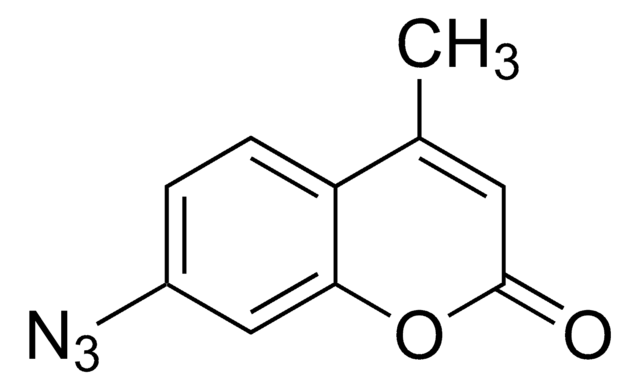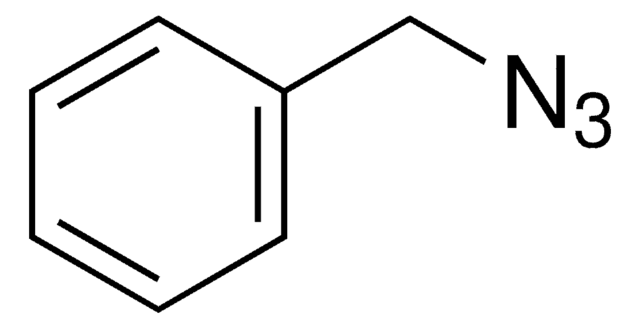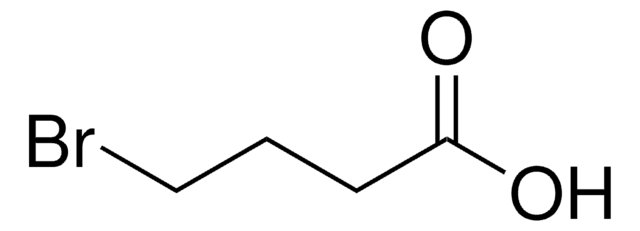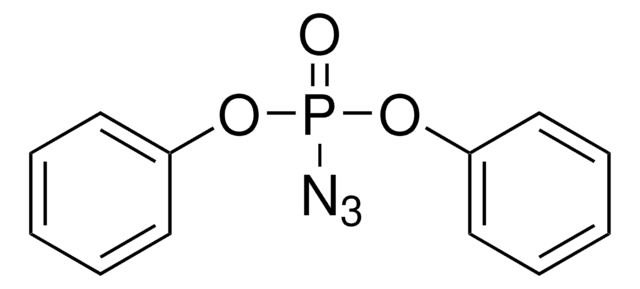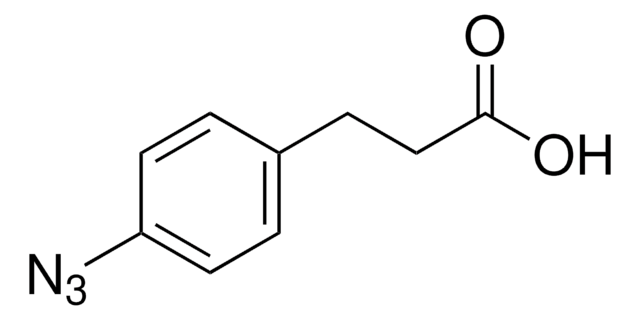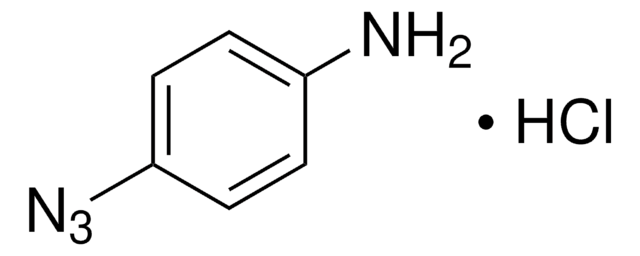778877
4-Azidobenzoic acid solution
~0.2 M in tert-butyl methyl ether, ≥95.0% (HPLC)
Sinónimos:
9-Azidobenzoic acid solution
Iniciar sesiónpara Ver la Fijación de precios por contrato y de la organización
About This Item
Fórmula empírica (notación de Hill):
C7H5N3O2
Número de CAS:
Peso molecular:
163.13
Beilstein:
1950876
Número MDL:
Código UNSPSC:
12352106
ID de la sustancia en PubChem:
NACRES:
NA.22
Productos recomendados
Nivel de calidad
Ensayo
≥95.0% (HPLC)
Formulario
liquid
concentración
~0.2 M in tert-butyl methyl ether
impurezas
≤2.0% water
temp. de almacenamiento
2-8°C
cadena SMILES
OC(C1=CC=C(N=[N+]=[N-])C=C1)=O
InChI
1S/C7H5N3O2/c8-10-9-6-3-1-5(2-4-6)7(11)12/h1-4H,(H,11,12)
Clave InChI
PQXPAFTXDVNANI-UHFFFAOYSA-N
Categorías relacionadas
Descripción general
4-Azidobenzoic acid is an aromatic azide generally used in copper(I)-catalyzed azide-alkyne cycloaddition reactions.
Aplicación
Review
Palabra de señalización
Danger
Frases de peligro
Consejos de prudencia
Clasificaciones de peligro
Flam. Liq. 2 - Skin Irrit. 2 - STOT RE 2
Órganos de actuación
Blood
Código de clase de almacenamiento
3 - Flammable liquids
Clase de riesgo para el agua (WGK)
WGK 3
Elija entre una de las versiones más recientes:
¿Ya tiene este producto?
Encuentre la documentación para los productos que ha comprado recientemente en la Biblioteca de documentos.
Renxun Chen et al.
Biofouling, 25(6), 517-524 (2009-05-02)
Infection associated with implanted biomaterials is common and costly and such infections are extremely resistant to antibiotics and host defenses. Consequently, there is a need to develop surfaces which resist bacterial adhesion and colonization. The broad spectrum synthetic cationic peptide
Todd A Rickett et al.
Biomacromolecules, 12(1), 57-65 (2010-12-07)
Restoring continuity to severed peripheral nerves is crucial to regeneration and enables functional recovery. However, the two most common agents for coaptation, sutures and fibrin glues, have drawbacks such as inflammation, pathogenesis, and dehiscence. Chitosan-based adhesives are a promising alternative
Hirokazu Hasuda et al.
Biomaterials, 26(15), 2401-2406 (2004-12-09)
Photoreactive pullulan was prepared, the polymer was photoimmobilized on polymeric or organic surfaces, and its interactions with a protein and a cell type were investigated. The photoreactive pullulan was synthesized by a coupling reaction with 4-azidobenzonic acid. Surface modification was
Y Ito et al.
Biotechnology progress, 12(5), 700-702 (1996-09-01)
Photoreactive insulin was synthesized by coupling with azidobenzoic acid. The insulin derivative was immobilized onto the wells of polystyrene culture plates by photoir-radiation. The photoimmobilized insulin enhanced the growth of anchorage-dependent cells such as Chinese hamster ovary CHO-K1 and mouse
Bao Li et al.
Regenerative biomaterials, 5(3), 159-166 (2018-06-27)
Photo-reactive poly(vinyl alcohol) (PRPVA) was synthesized by introduction of phenyl azido groups into poly(vinyl alcohol) (PVA) and applied for surface modification. PRPVA was grafted onto cell culture plate surface homogeneously or in a micropattern. Human mesenchymal stem cells (hMSCs) cultured
Nuestro equipo de científicos tiene experiencia en todas las áreas de investigación: Ciencias de la vida, Ciencia de los materiales, Síntesis química, Cromatografía, Analítica y muchas otras.
Póngase en contacto con el Servicio técnico